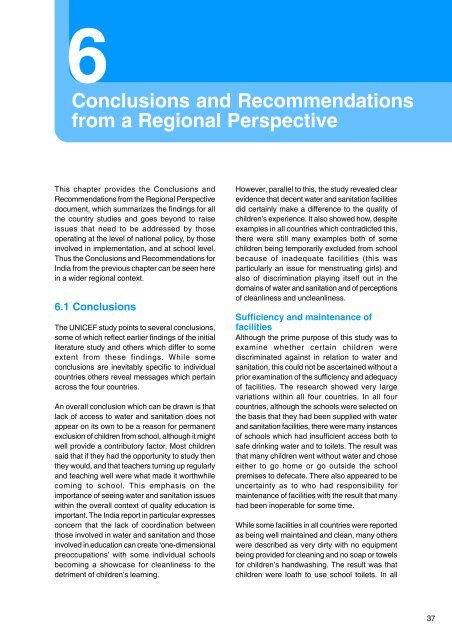Equity in School Water and Sanitation
Equity in School Water and Sanitation
Equity in School Water and Sanitation
Create successful ePaper yourself
Turn your PDF publications into a flip-book with our unique Google optimized e-Paper software.
6Overcom<strong>in</strong>g Exclusion <strong>and</strong> Discrim<strong>in</strong>ation <strong>in</strong> South AsiaIndia Country ReportConclusions <strong>and</strong> Recommendationsfrom a Regional PerspectiveThis chapter provides the Conclusions <strong>and</strong>Recommendations from the Regional Perspectivedocument, which summarizes the f<strong>in</strong>d<strong>in</strong>gs for allthe country studies <strong>and</strong> goes beyond to raiseissues that need to be addressed by thoseoperat<strong>in</strong>g at the level of national policy, by those<strong>in</strong>volved <strong>in</strong> implementation, <strong>and</strong> at school level.Thus the Conclusions <strong>and</strong> Recommendations forIndia from the previous chapter can be seen here<strong>in</strong> a wider regional context.6.1 ConclusionsThe UNICEF study po<strong>in</strong>ts to several conclusions,some of which reflect earlier f<strong>in</strong>d<strong>in</strong>gs of the <strong>in</strong>itialliterature study <strong>and</strong> others which differ to someextent from these f<strong>in</strong>d<strong>in</strong>gs. While someconclusions are <strong>in</strong>evitably specific to <strong>in</strong>dividualcountries others reveal messages which perta<strong>in</strong>across the four countries.An overall conclusion which can be drawn is thatlack of access to water <strong>and</strong> sanitation does notappear on its own to be a reason for permanentexclusion of children from school, although it mightwell provide a contributory factor. Most childrensaid that if they had the opportunity to study thenthey would, <strong>and</strong> that teachers turn<strong>in</strong>g up regularly<strong>and</strong> teach<strong>in</strong>g well were what made it worthwhilecom<strong>in</strong>g to school. This emphasis on theimportance of see<strong>in</strong>g water <strong>and</strong> sanitation issueswith<strong>in</strong> the overall context of quality education isimportant. The India report <strong>in</strong> particular expressesconcern that the lack of coord<strong>in</strong>ation betweenthose <strong>in</strong>volved <strong>in</strong> water <strong>and</strong> sanitation <strong>and</strong> those<strong>in</strong>volved <strong>in</strong> education can create ‘one-dimensionalpreoccupations’ with some <strong>in</strong>dividual schoolsbecom<strong>in</strong>g a showcase for cleanl<strong>in</strong>ess to thedetriment of children’s learn<strong>in</strong>g.However, parallel to this, the study revealed clearevidence that decent water <strong>and</strong> sanitation facilitiesdid certa<strong>in</strong>ly make a difference to the quality ofchildren’s experience. It also showed how, despiteexamples <strong>in</strong> all countries which contradicted this,there were still many examples both of somechildren be<strong>in</strong>g temporarily excluded from schoolbecause of <strong>in</strong>adequate facilities (this wasparticularly an issue for menstruat<strong>in</strong>g girls) <strong>and</strong>also of discrim<strong>in</strong>ation play<strong>in</strong>g itself out <strong>in</strong> thedoma<strong>in</strong>s of water <strong>and</strong> sanitation <strong>and</strong> of perceptionsof cleanl<strong>in</strong>ess <strong>and</strong> uncleanl<strong>in</strong>ess.Sufficiency <strong>and</strong> ma<strong>in</strong>tenance offacilitiesAlthough the prime purpose of this study was toexam<strong>in</strong>e whether certa<strong>in</strong> children werediscrim<strong>in</strong>ated aga<strong>in</strong>st <strong>in</strong> relation to water <strong>and</strong>sanitation, this could not be ascerta<strong>in</strong>ed without aprior exam<strong>in</strong>ation of the sufficiency <strong>and</strong> adequacyof facilities. The research showed very largevariations with<strong>in</strong> all four countries. In all fourcountries, although the schools were selected onthe basis that they had been supplied with water<strong>and</strong> sanitation facilities, there were many <strong>in</strong>stancesof schools which had <strong>in</strong>sufficient access both tosafe dr<strong>in</strong>k<strong>in</strong>g water <strong>and</strong> to toilets. The result wasthat many children went without water <strong>and</strong> choseeither to go home or go outside the schoolpremises to defecate. There also appeared to beuncerta<strong>in</strong>ty as to who had responsibility forma<strong>in</strong>tenance of facilities with the result that manyhad been <strong>in</strong>operable for some time.While some facilities <strong>in</strong> all countries were reportedas be<strong>in</strong>g well ma<strong>in</strong>ta<strong>in</strong>ed <strong>and</strong> clean, many otherswere described as very dirty with no equipmentbe<strong>in</strong>g provided for clean<strong>in</strong>g <strong>and</strong> no soap or towelsfor children’s h<strong>and</strong>wash<strong>in</strong>g. The result was thatchildren were loath to use school toilets. In all37












